Three-Dimensional Geological Modeling of the Shallow Subsurface and Its Application: A Case Study in Tongzhou District, Beijing, China
Abstract
1. Introduction
2. Quaternary Geology
3. Data and Method
3.1. Geological Data
3.2. Method
3.2.1. Three-Dimensional Modeling Workflow
3.2.2. Cross-Section Method
- Checking original paper files and new borehole information. Describing the specific position of different layers, including top and base depth, coordinates (x, y, z), etc.
- Comparing each lithology record with that of other boreholes in the near vicinity, especially of its nearest neighbors. If the target soil type recorded in one borehole is consistent with that of surrounding boreholes at a similar depth, the soil name of the target layer would be followed or would be treated as a lens.
- Attribute data verification. This is a further validation by geotechnical parameters, which are generally relative to soil types. The properties of each type of soil normally have a specific attribute value range, for example, the natural water content of silty clay is generally between 15 and 40%, while the plastic limit value is mainly between 12 and 23%. Therefore, property values can be used as a further check on the consistency of the lithology. Records that seemed to be in some way unreliable were noted and then discarded.
- Connecting main layers. A main layer means a thick unit that is widely and continuously distributed within the area. The artificial ground, clayey silt, silty clay, silt–fine sand, and medium–coarse sand/gravel layer were connected in the study area.
- Coding layers and lenses. A code represents the order and soil types modeled and is unique.
- A series of geological records of the same layer in the vertical direction from various boreholes that belonged to the same cross-section line (for example, boreholes along line WE08 on Figure 5), in essence, defined one succession, on condition that the slope among them was small.
- Delineation of lenses. If the thickness of a lens exceeded 0.5 m, it was pinched out at the left and right ends of the target borehole; otherwise, it was pinched out at 1/2 of the general spacing of boreholes. Thin layers with a thickness of less than 0.2 m but presenting typical stratigraphic features, for example, a succession of clay with symbolic significance, were reserved.
3.2.3. Kriging
4. Results and Discussion
4.1. Subsurface Stratigraphy
4.2. Three-Dimensional Property Model
4.2.1. Water Content (w%) and Initial Void Ratio (e)
4.2.2. Compression Modulus (Es)
5. Applications
5.1. Depth Variations
5.2. Es Distribution
5.3. Dynamic Monitoring Model
6. Conclusions
Author Contributions
Funding
Institutional Review Board Statement
Informed Consent Statement
Data Availability Statement
Acknowledgments
Conflicts of Interest
References
- Wang, C.S.; Zhou, C.H.; Peng, J.B.; Fan, J.; Zhu, H.H.; Li, X.Z.; Cheng, G.H.; Dai, C.S.; Xu, N.X. A discussion on high-quality development and sustainable utilization of China’s urban underground space in the new era. Earth Sci. Front. 2019, 26, 1–8, (In Chinese with English abstract). [Google Scholar]
- Aldiss, D.T.; Black, M.G.; Entwisle, D.C.; Page, D.P.; Terrington, R.L. Benefits of a 3D geological model for major tunnelling works: An example from Farringdon, east–central London, UK. Q. J. Eng. Geol. Hydrogeol. 2012, 45, 405–414. [Google Scholar] [CrossRef]
- Andersen, T.R.; Poulsen, S.E.; Pagola, M.A.; Medhus, A.B. Geophysical mapping and 3D geological modelling to support urban planning: A case study from Vejle, Denmark. J. Appl. Geophys. 2020, 180, 104130. [Google Scholar] [CrossRef]
- Costa, A.L.; Sousa, R.L.; Einstein, H.H. Probabilistic 3D alignment optimization of underground transport infrastructure integrating GIS-based subsurface characterization. Tunn. Undergr. Space Technol. 2017, 72, 233–241. [Google Scholar] [CrossRef]
- Culshaw, M.G. From concept towards reality: Developing the attributed 3D geological model of the shallow subsurface. Q. J. Eng. Geol. Hydrogeol. 2005, 38, 231–284. [Google Scholar] [CrossRef]
- Zhou, D.K.; Li, X.Z.; Wang, Q.; Wang, R.; Wang, T.D.; Gu, Q.; Xin, Y.X. GIS-based urban underground space resources evaluation toward three-dimensional land planning: A case study in Nantong, China. Tunn. Undergr. Space Technol. 2019, 84, 1–10. [Google Scholar] [CrossRef]
- Dong, M.; Neukum, C.; Hu, H.; Azzam, R. Real 3D geotechnical modeling in engineering geology: A case study from the inner city of Aachen, Germany. Bull. Eng. Geol. Environ. 2015, 74, 281–300. [Google Scholar] [CrossRef]
- Maio, R.D.; Paola, C.D.; Forte, G.; Piegari, E.; Urciuoli, G. An integrated geological, geotechnical and geophysical approach to identify predisposing factors for flowslide occurrence. Eng. Geol. 2020, 267, 105473. [Google Scholar] [CrossRef]
- Hou, W.; Yang, L.; Deng, D.; Ye, J.; Clarke, K.; Yang, Z.; Zhuang, W.; Liu, J.; Huang, J. Assessing quality of urban underground spaces by coupling 3D geological models: The case study of Foshan city, South China. Comput. Geosci. 2016, 89, 1–11. [Google Scholar] [CrossRef]
- Rienzo, F.D.; Oreste, P.; Pelizza, S. Subsurface geological-geotechnical modelling to sustain underground civil planning. Eng. Geol. 2008, 96, 187–204. [Google Scholar] [CrossRef]
- Rienzo, F.D.; Oreste, P.; Pelizza, S. 3D GIS Supporting Underground Urbanisation in the City of Turin (Italy). Geotech. Geol. Eng. 2009, 27, 539–547. [Google Scholar] [CrossRef]
- Royse, K.R.; Rutter, H.K.; Entwisle, D.C. Property attribution of 3D geological models in the Thames Gateway, London: New ways of visualising geoscientific information. Bull. Eng. Geol. Environ. 2008, 68, 1–16. [Google Scholar] [CrossRef]
- Breunig, M. An approach to the integration of spatial data and systems for a 3D geo-information system. Comput. Geosci. 1999, 25, 39–48. [Google Scholar] [CrossRef]
- Lemon, A.M.; Jones, N.L. Building solid models from boreholes and user-defined cross-sections. Comput. Geosci. 2003, 29, 547–555. [Google Scholar] [CrossRef]
- Wu, Q.; Xu, H.; Zou, X.K. An effective method for 3D geological modeling with multi-source data integration. Comput. Geosci. 2005, 31, 35–43. [Google Scholar] [CrossRef]
- Maccormack, K.; Arnaud, E.; Parker, B.L. Using a Multiple Variogram Approach to Improve the Accuracy of Subsurface Geological Models. Can. J. Earth Sci. 2017, 55, 786–801. [Google Scholar] [CrossRef]
- Touch, S.; Likitlersuang, S.; Pipatpongsa, T. 3D geological modelling and geotechnical characteristics of Phnom Penh subsoils in Cambodia. Eng. Geol. 2014, 178, 58–69. [Google Scholar] [CrossRef]
- Turner, A.K. Challenges and trends for geological modelling and visualisation. Bull. Eng. Geol. Environ. 2006, 65, 109–127. [Google Scholar] [CrossRef]
- Zhang, F.; Zhu, H.H.; Ning, M.X. Modeling method of 3D strata suitable for massive data. Chin. J. Rock Mech. Eng. 2006, 25, 3305–3310, (In Chinese with English abstract). [Google Scholar]
- Zhu, L.F.; Zhang, C.J.; Li, M.J.; Pan, X.; Sun, J.Z. Building 3D solid models of sedimentary stratigraphic systems from borehole data: An automatic method and case studies. Eng. Geol. 2012, 127, 1–13. [Google Scholar] [CrossRef]
- Caumon, G.; Gray; Antoine, C.; Titeux, M.-O. Three-Dimensional Implicit Stratigraphic Model Building From Remote Sensing Data on Tetrahedral Meshes: Theory and Application to a Regional Model of La Popa Basin, NE Mexico. IEEE Trans. Geosci. Remote Sens. 2013, 51, 1613–1621. [Google Scholar] [CrossRef]
- Caumon, G.; Collon-Drouaillet, P.; Veslud, C.L.C.D.; Viseur, S.; Sausse, J. Surface-Based 3D Modeling of Geological Structures. Math. Geosci. 2009, 41, 927–945. [Google Scholar] [CrossRef]
- Frank, T.; Tertois, A.L.; Mallet, J.L. 3D-reconstruction of complex geological interfaces from irregularly distributed and noisy point data. Comput. Geosci. 2007, 33, 932–943. [Google Scholar] [CrossRef]
- Jørgensen, F.; Høyer, A.-S.; Sandersen, P.B.E.; He, X.L.; Foged, N. Combining 3D geological modelling techniques to address variations in geology, data type and density—An example from Southern Denmark. Comput. Geosci. 2015, 81, 53–63. [Google Scholar] [CrossRef]
- Pellerin, J.; Lévy, B.; Caumon, G.; Botella, A. Automatic surface remeshing of 3D structural models at specified resolution: A method based on Voronoi diagrams. Comput. Geosci. 2014, 62, 103–116. [Google Scholar] [CrossRef]
- Wang, Z.G.; Qu, H.G.; Wu, Z.X.; Yang, H.J.; Du, Q.L. Formal representation of 3D structural geological models. Comput. Geosci. 2016, 90, 10–23. [Google Scholar] [CrossRef]
- Gallerini, G.; Donatis, M. 3D modeling using geognostic data: The case of the low valley of Foglia river (Italy). Comput. Geosci. 2009, 35, 146–164. [Google Scholar] [CrossRef]
- Travelletti, J.; Malet, J.P. Characterization of the 3D geometry of flow-like landslides: A methodology based on the integration of heterogeneous multi-source data. Eng. Geol. 2012, 128, 30–48. [Google Scholar] [CrossRef]
- Zhu, L.F.; Li, M.J.; Li, C.L.; Shang, J.G.; Chen, G.L.; Zhang, B.; Wang, X.F. Coupled modeling between geological structure fields and property parameter fields in 3D engineering geological space. Eng. Geol. 2013, 167, 105–116. [Google Scholar] [CrossRef]
- Collon, P.; Steckiewicz-Laurent, W.; Pellerin, J.; Laurent, G.; Caumon, G.; Reichart, G.; Vaute, L. 3D geomodelling combining implicit surfaces and Voronoi-based remeshing: A case study in the Lorraine Coal Basin (France). Comput. Geosci. 2015, 77, 29–43. [Google Scholar] [CrossRef]
- Price, S.J.; Terrington, R.L.; Busby, J.; Bricker, S.; Berry, T. 3D ground-use optimisation for sustainable urban development planning: A case-study from Earls Court, London, UK. Tunn. Undergr. Space Technol. 2018, 81, 144–164. [Google Scholar] [CrossRef]
- Rodríguez, A.A.; Kuhlmann, U.; Marschall, P. 3D modelling of the Excavation Damaged Zone using a Marked Point Process technique. Geomech. Energy Environ. 2018, 17, 29–46. [Google Scholar] [CrossRef]
- Ye, S.; Luo, Y.; Wu, J.; Yan, X.; Wang, H.; Jiao, X.; Teatini, P. Three-dimensional numerical modeling of land subsidence in Shanghai, China. Hydrogeol. J. 2016, 24, 695–709. [Google Scholar] [CrossRef]
- May, M.E.; Dlala, M.; Chenini, I. Urban geological mapping: Geotechnical data analysis for rational development planning. Eng. Geol. 2010, 116, 129–138. [Google Scholar] [CrossRef]
- Rohmer, O.; Bertrand, E.; Mercerat, E.D.; Régnier, J.; Alvarez, M. Combining borehole log-stratigraphies and ambient vibration data to build a 3D Model of the Lower Var Valley, Nice (France). Eng. Geol. 2020, 270, 105588. [Google Scholar] [CrossRef]
- Burke, H.; Mathers, S.J.; Williamson, J.P.; Thorpe, S.; Ford, J.; Terrington, R.L. The London Basin Superficial and Bedrock LithoFrame 50 Model; British Geological Survey: Nottingham, UK, 2014. [Google Scholar]
- Ford, J.R.; Burke, H.; Royse, K.R.; Mathers, S.J. The 3D Geology of London and the Thames Gateway: A Modern Approach to Geological Surveying and Its Relevance in the Urban Environment; British Geological Survey: Nottingham, UK, 2008. [Google Scholar]
- MacCormack, K.E.; Berg, R.C.; Kessler, H.; Russell, H.A.J.; Thorleifson, L.H. 2019 Synopsis of Current Three-Dimensional Geological Mapping and Modeling in Geological Survey Organizations; AER/AGS Special Report 112; Alberta Energy Regulator/Alberta Geological Survey: Edmonton, AB, Canada, 2019. [Google Scholar]
- Høyer, A.S.; Klint, K.E.S.; Fiandaca, G.; Maurya, P.K.; Christiansen, A.V.; Balbarini, N.; Bjerg, P.L.; Hansen, T.B.; Mller, I. Development of a high-resolution 3D geological model for landfill leachate risk assessment. Eng. Geol. 2019, 249, 45–59. [Google Scholar] [CrossRef]
- Chen, Q.; Liu, G.; Ma, X.; Li, X.; He, Z. 3D stochastic modeling framework for Quaternary sediments using multiple-point statistics: A case study in Minjiang Estuary area, Southeast China. Comput. Geosci. 2019, 136, 104404. [Google Scholar] [CrossRef]
- Cai, X.M.; Luan, Y.B.; Guo, G.X.; Liang, Y.N. 3D Quaternary geological structure of Beijing plain. Geol. China 2009, 36, 1021–1029, (In Chinese with English abstract). [Google Scholar]
- Zhi, C.; Chen, H.; Li, P.; Ma, C.; Zhang, J.; Zhang, C.; Wang, C.; Yue, X. Spatial distribution of arsenic along groundwater flow path in Chaobai River alluvial–proluvial fan, North China Plain. Environ. Earth Sci. 2019, 78, 259. [Google Scholar] [CrossRef]
- Che, Z. A study of the fault activity in the capital circle. North China Earthq. Sci. 1993, 11, 23–34. [Google Scholar]
- Jiang, W.L.; Hou, Z.H.; Xie, X. Research on paleoearthquakes in Jiuxian trenches across Nankou-Sunhe fault zone in Changping County of Beijing plain. Sci. China 2002, 45, 160–173. [Google Scholar] [CrossRef]
- Zhang, S.M.; Wang, D.D.; Liu, X.D.; Zhang, G.H.; Zhao, J.X.; Luo, M.H.; Ren, J.J.; Wang, R.; Zhang, Y. Using borehole core analysis to reveal Late Quaternary paleoearthquakes along the Nankou-Sunhe Fault, Beijing. Sci. China Ser D Earth Sci. 2008, 51, 1154–1168. [Google Scholar] [CrossRef]
- Huang, M.; Ninic, J.; Zhang, Q. BIM, machine learning and computer vision techniques in underground construction: Current status and future perspectives. Tunn. Undergr. Space Technol. 2021, 108, 103677. [Google Scholar] [CrossRef]
- He, H.H.; Jing, H.; Xiao, J.Z.; Zhou, Y.X.; Liu, Y.; Li, C. 3D geological modeling and engineering properties of shallow superficial deposits: A case study in Beijing, China. Tunn. Undergr. Space Technol. 2020, 100, 103390. [Google Scholar] [CrossRef]
- Michel, D.; Roger, A. Geostatistical Ore Reserve Estimation; Elsevier Scientific Pub. Co.: Amsterdam, The Netherland, 1977. [Google Scholar]
- Isaaks, E.H.; Srivastava, R.H. An Introduction to Applied Geostatistics; Oxford University Press: New York, NY, USA, 1989. [Google Scholar]
- Krige, D.G. A statistical approach to some basic mine valuation problems on the Witwatersrand. J. South Afr. Inst. Min. Metall. 1952, 52, 119–139. [Google Scholar]
- Triantafilis, J.; Odeh, I.; Mcbratney, A.B. Five Geostatistical Models to Predict Soil Salinity from Electromagnetic Induction Data Across Irrigated Cotton. Soil Sci. Soc. Am. J. 2001, 65, 869–878. [Google Scholar] [CrossRef]
- Lloyd, C.D.; Atkinson, P.M. Assessing uncertainty in estimates with ordinary and indicator kriging. Comput. Geosci. 2001, 27, 929–937. [Google Scholar] [CrossRef]
- Kravchenko, A.N. Influence of Spatial Structure on Accuracy of Interpolation Methods. Soil Sci. Soc. Am. J. 2003, 67, 1564–1571. [Google Scholar] [CrossRef]
- Zimmerman, D.L.; Zimmerman, M.B. A Comparison of Spatial Semivariogram Estimators and Corresponding Ordinary Kriging Predictors. Technometrics 1991, 33, 77–91. [Google Scholar] [CrossRef]
- Liu, D.; Wang, Z.; Zhang, B.; Song, K.; Duan, H. Spatial distribution of soil organic carbon and analysis of related factors in croplands of the black soil region, Northeast China. Agric. Ecosyst. Environ. 2006, 113, 73–81. [Google Scholar] [CrossRef]
- Webster, R.; Oliver, M.A. Geostatistics for Environmental Scientists, Second Edition; Wiley: Chichester, UK, 2008. [Google Scholar]
- Schokker, J.; Sandersen, P.; Beer, H.D.; Eriksson, I.; Kallio, H.; Kearsey, T.; Pfleiderer, S.; Seither, A. 3D Urban Subsurface Modelling and Visualisation—A Review of Good Practices and Techniques to Ensure Optimal Use of Geological Information in Urban Planning. COST European Cooperation in Science and Technology Sub-Urban WG2 Report. 2017. Available online: https://www.google.com.hk/url?sa=t&rct=j&q=&esrc=s&source=web&cd=&cad=rja&uact=8&ved=2ahUKEwi9suvtxPH8AhVfr1YBHSDnDOIQFnoECAkQAQ&url=https%3A%2F%2Fwww.researchgate.net%2Fpublication%2F317304360_3D_urban_subsurface_modelling_and_visualisation_-_a_review_of_good_practices_and_techniques_to_ensure_optimal_use_of_geological_information_in_urban_planning&usg=AOvVaw2M8yqT1ejj3boaKZ6frxeT (accessed on 26 January 2023).
- Saaty, T.L. Decision making with the analytic hierarchy process. Int. J. Serv. Sci. 2008, 1, 83–98. [Google Scholar] [CrossRef]
- He, J.; Zhou, Y.X.; Zheng, G.S.; Wang, J.M.; Liu, Y. Research on the Geological Suitability Evaluation System of Underground Space Resource Utilization in Beijing. Chin. J. Undergr. Space Eng. 2020, 16, 955–966, (In Chinese with English abstract). [Google Scholar]
- He, J.; He, H.H.; Zheng, G.S.; Liu, Y.; Zhou, Y.X.; Xiao, J.Z.; Wang, C.J. 3D geological modelling of superficial deposits in Beijing City. Geol. China 2019, 46, 244–254, (In Chinese with English abstract). [Google Scholar]
- Thierry, P.; Prunier-Leparmentier, A.-M.; Lembezat, C.; Vanoudheusden, E.; Vernoux, J.-F. 3D geological modelling at urban scale and mapping of ground movement susceptibility from gypsum dissolution: The Paris example (France). Eng. Geol. 2009, 105, 51–64. [Google Scholar] [CrossRef]
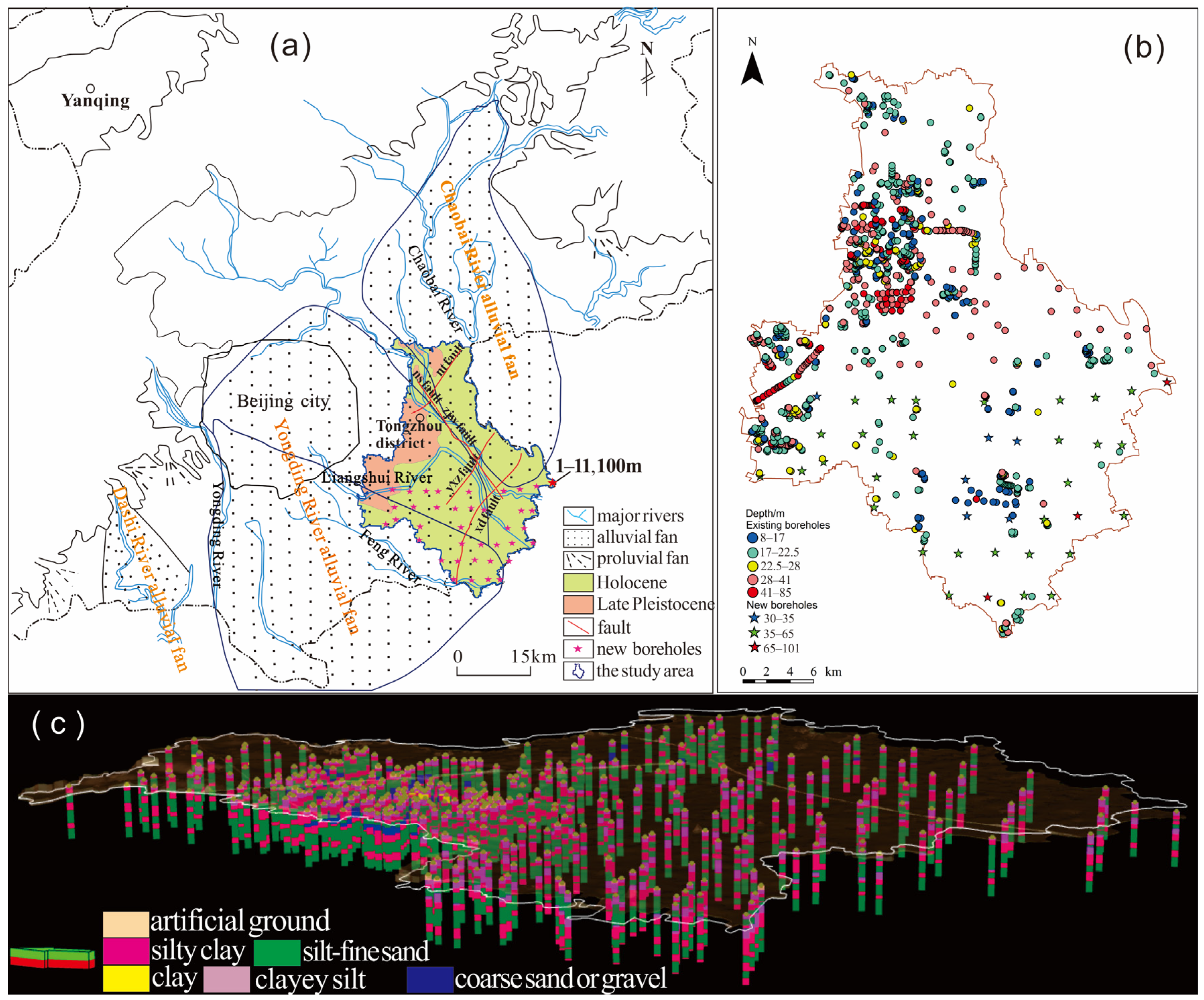
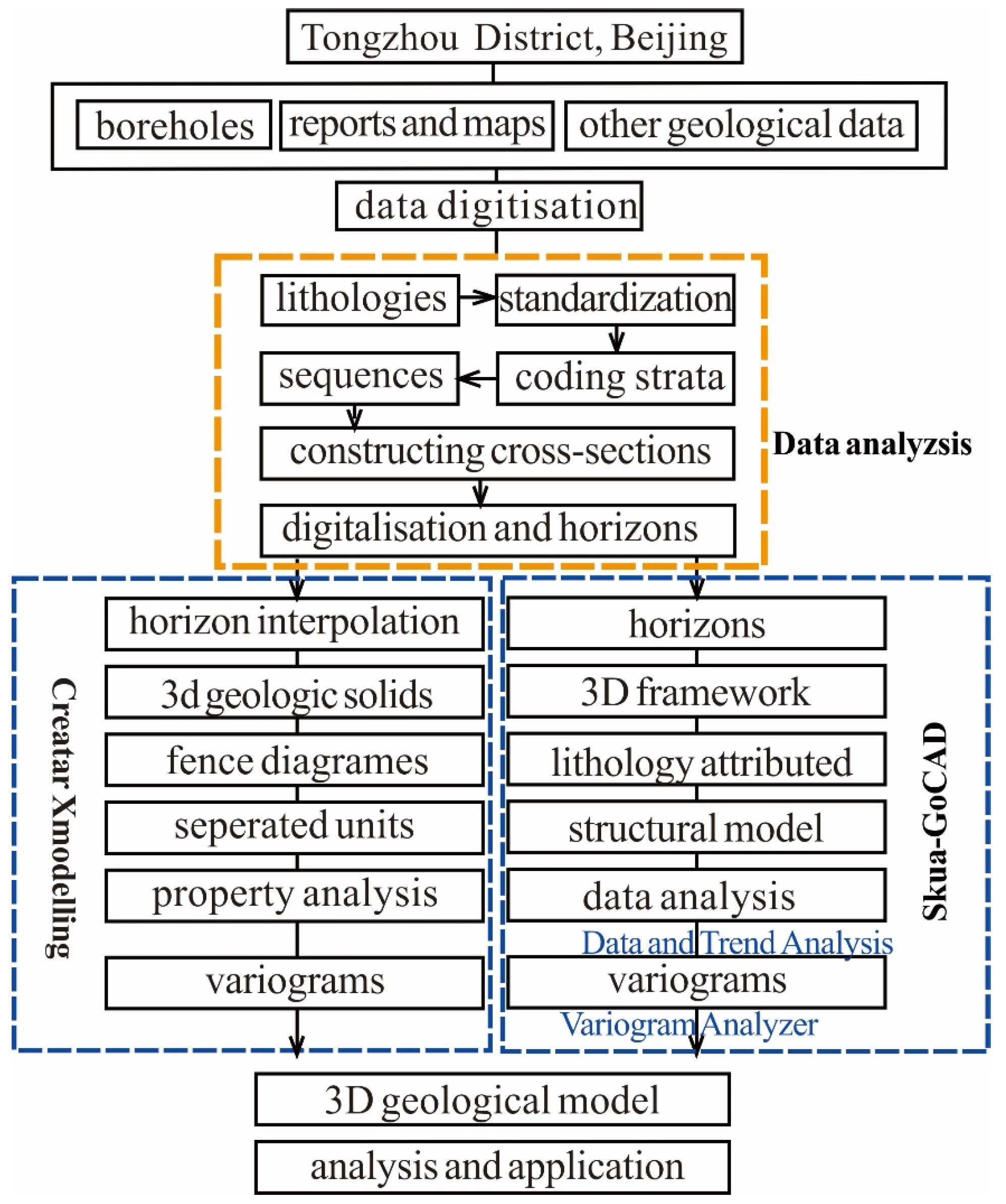
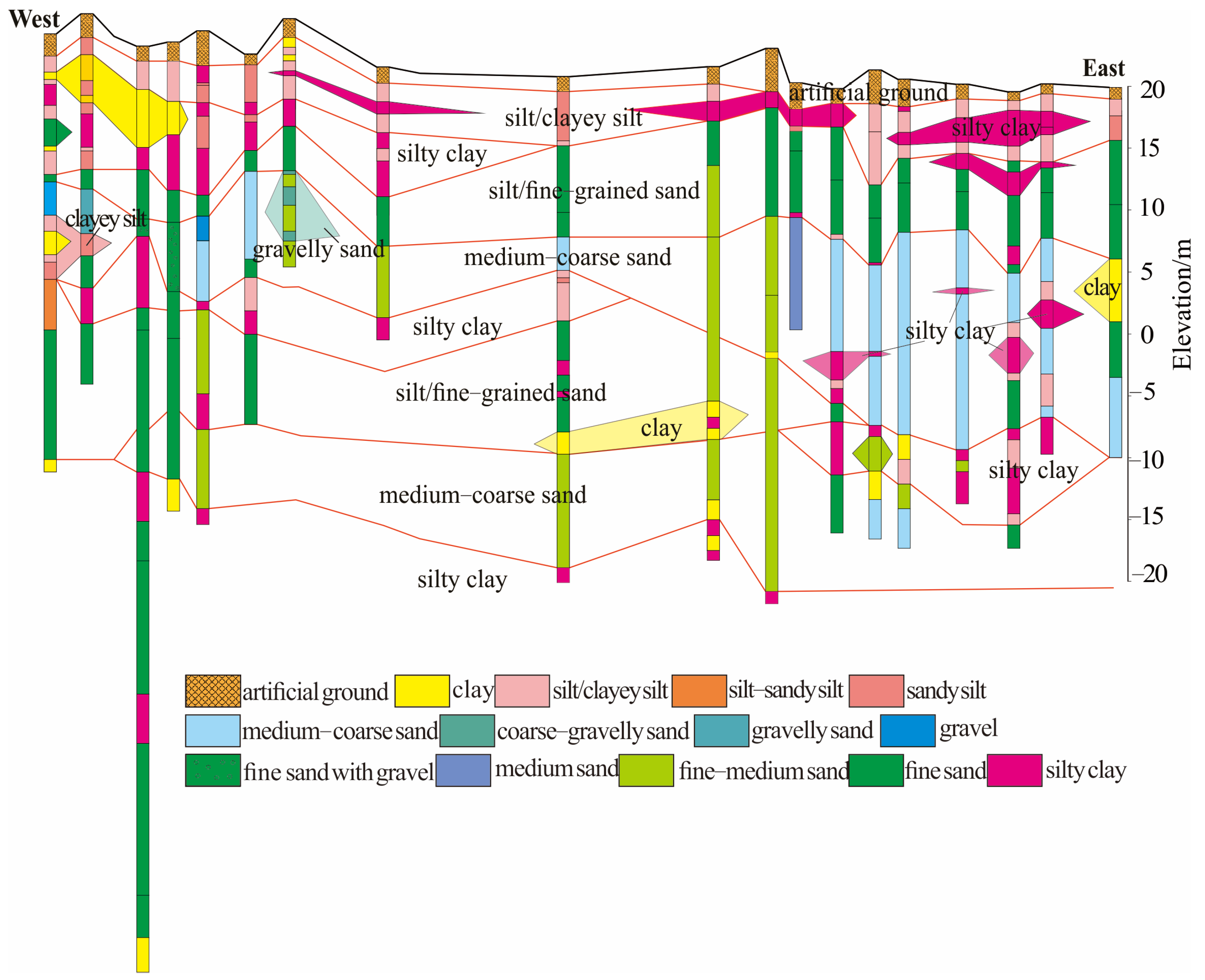
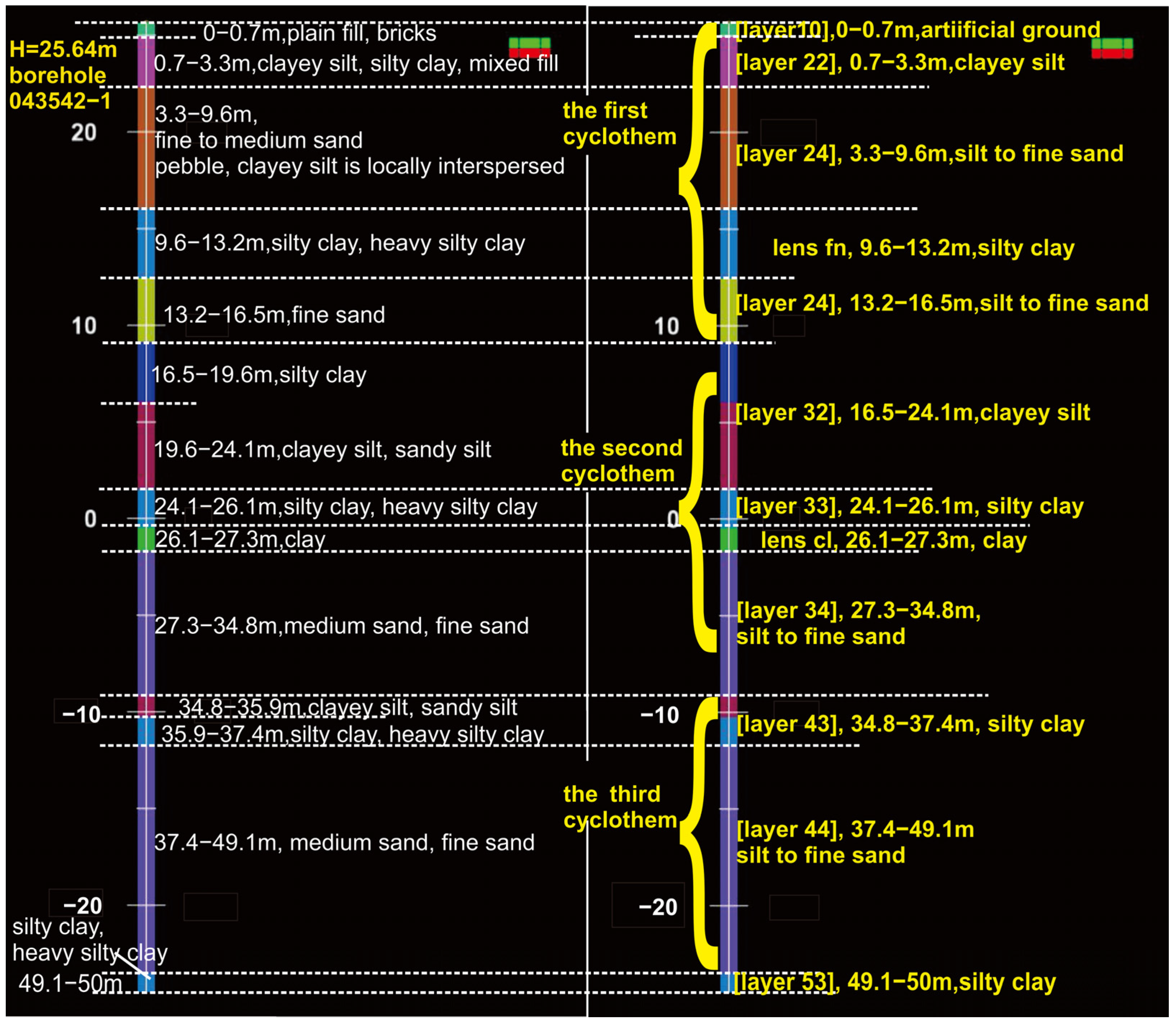




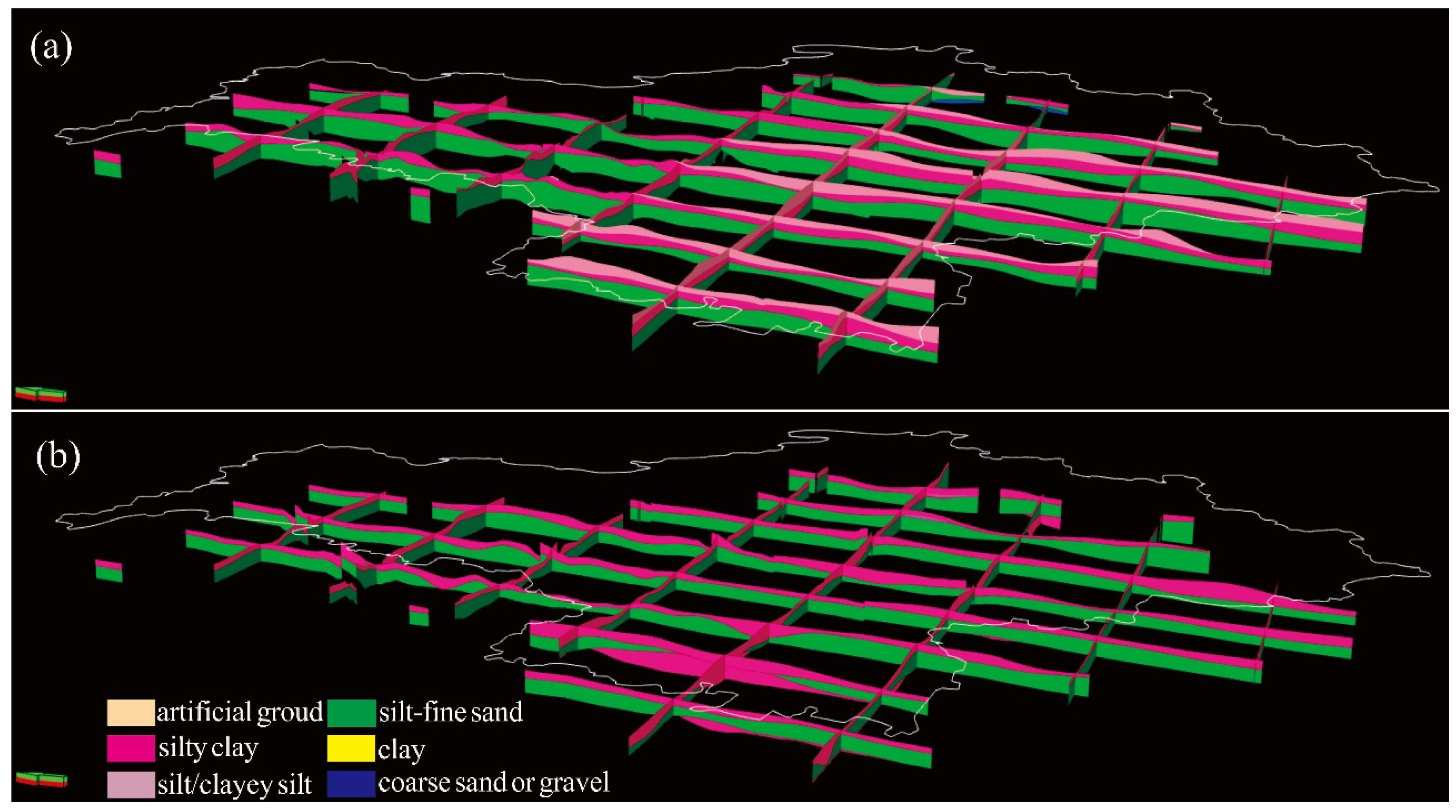
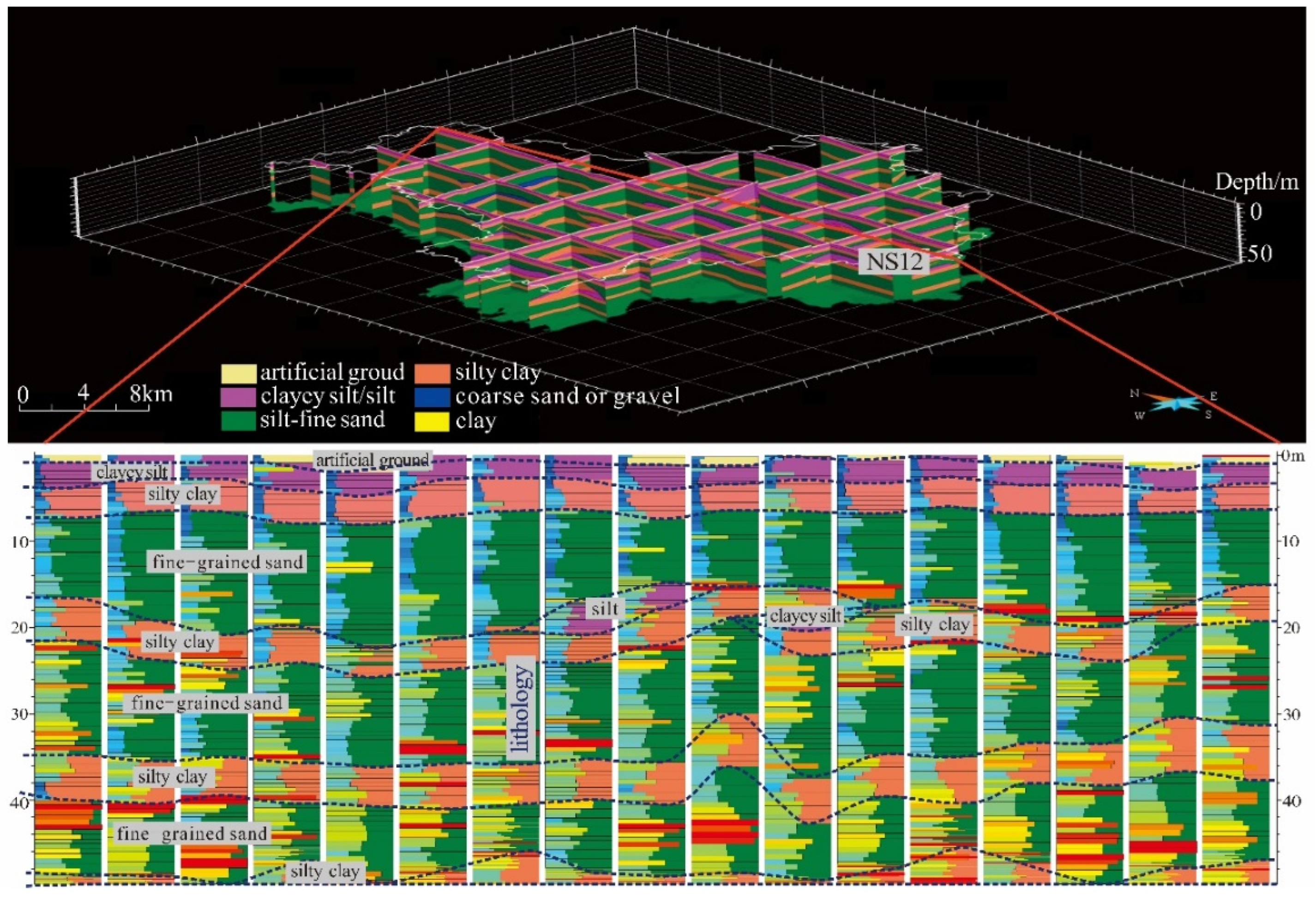
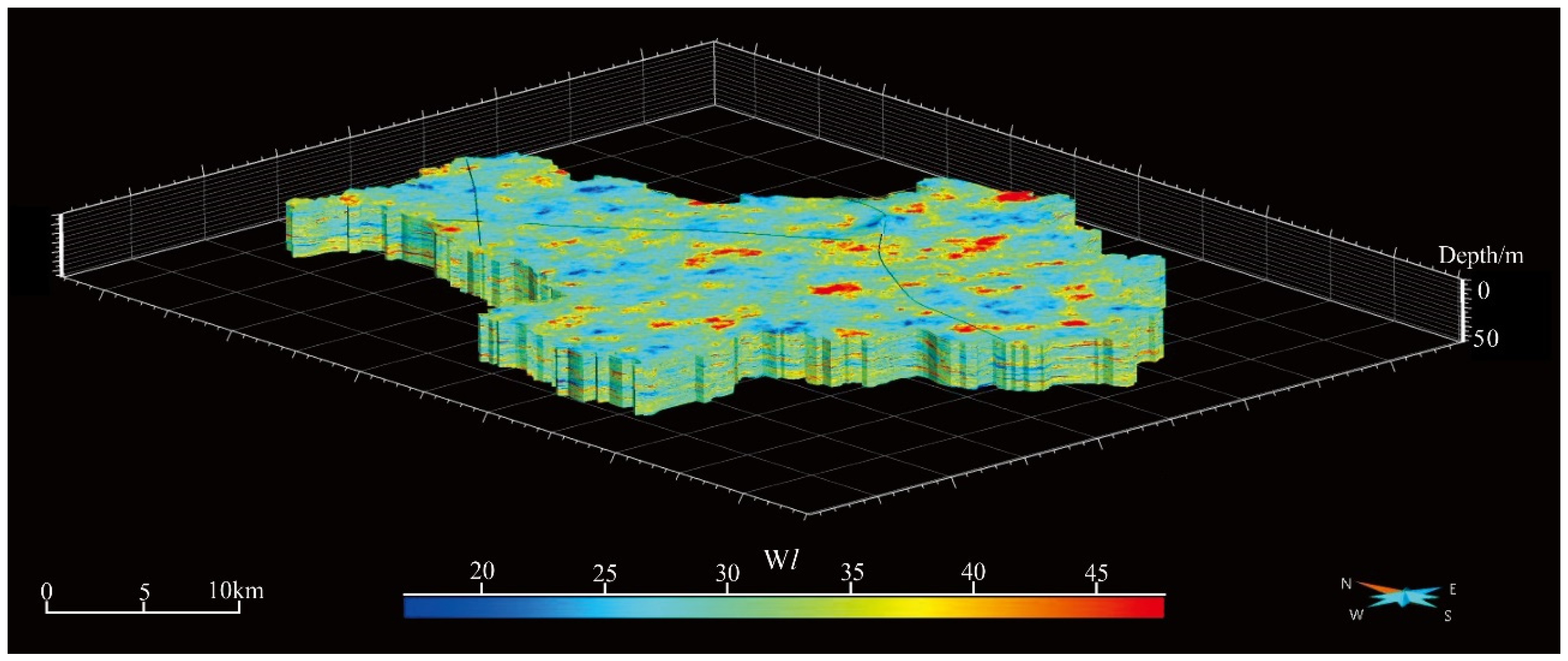
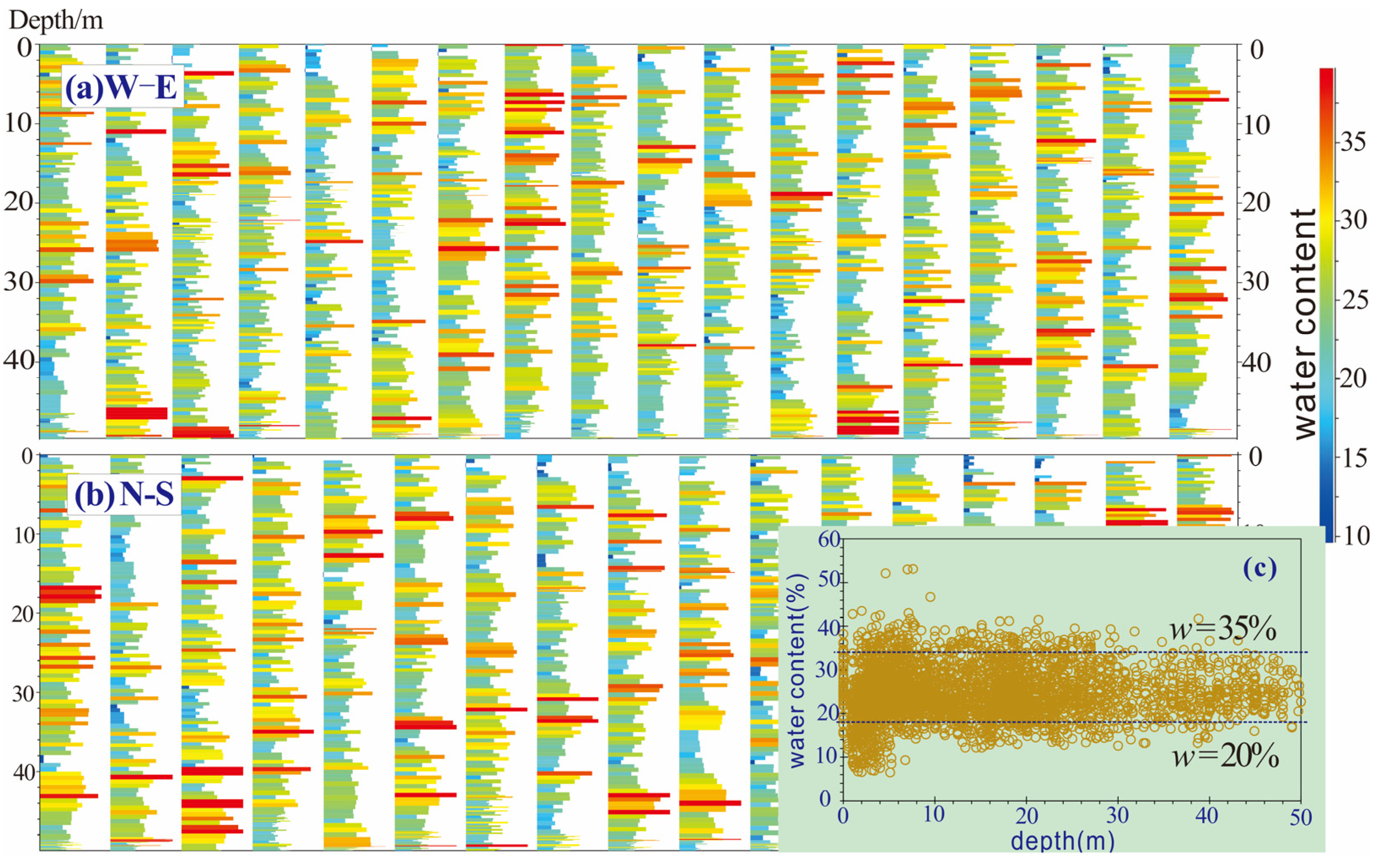

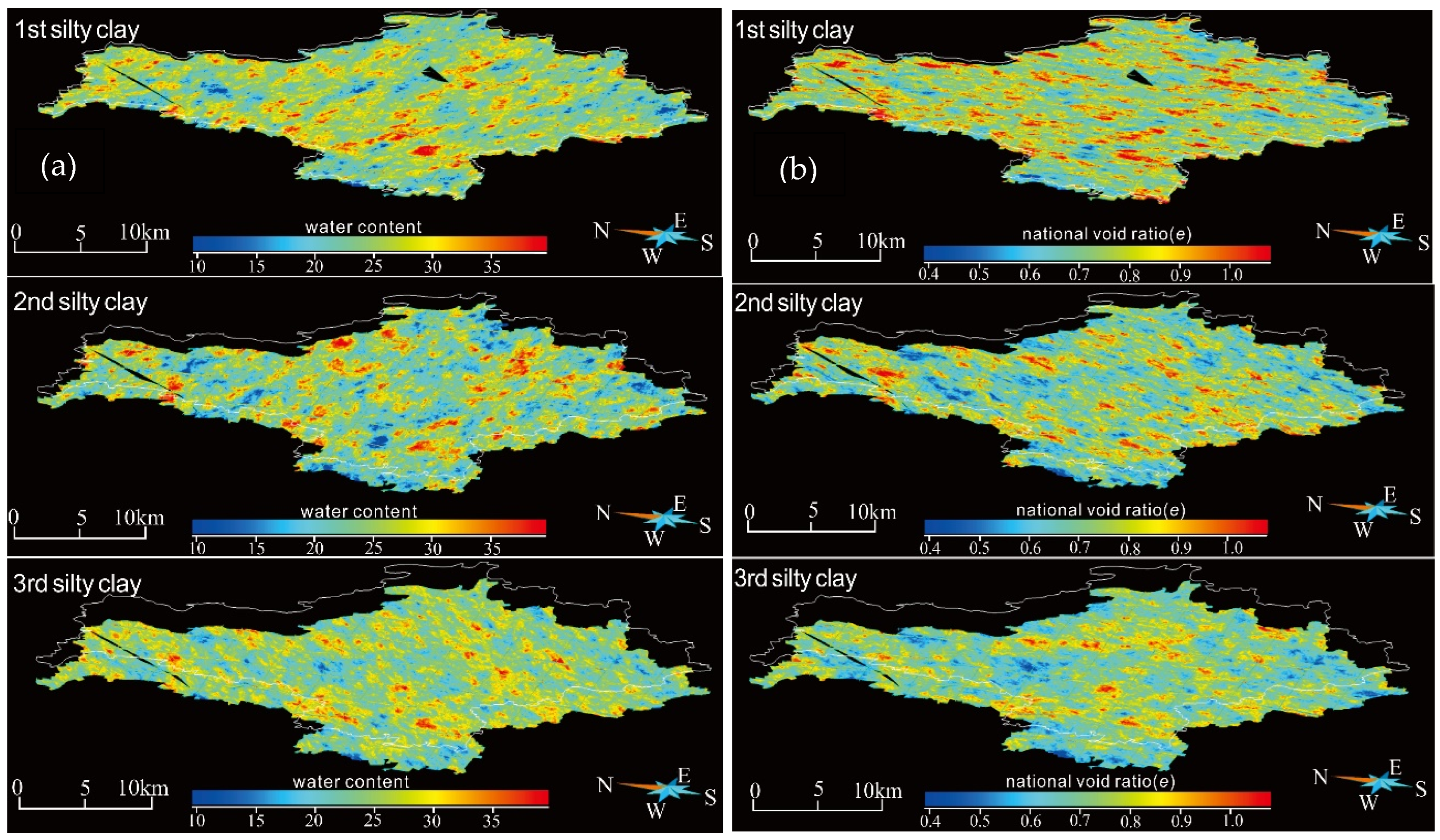




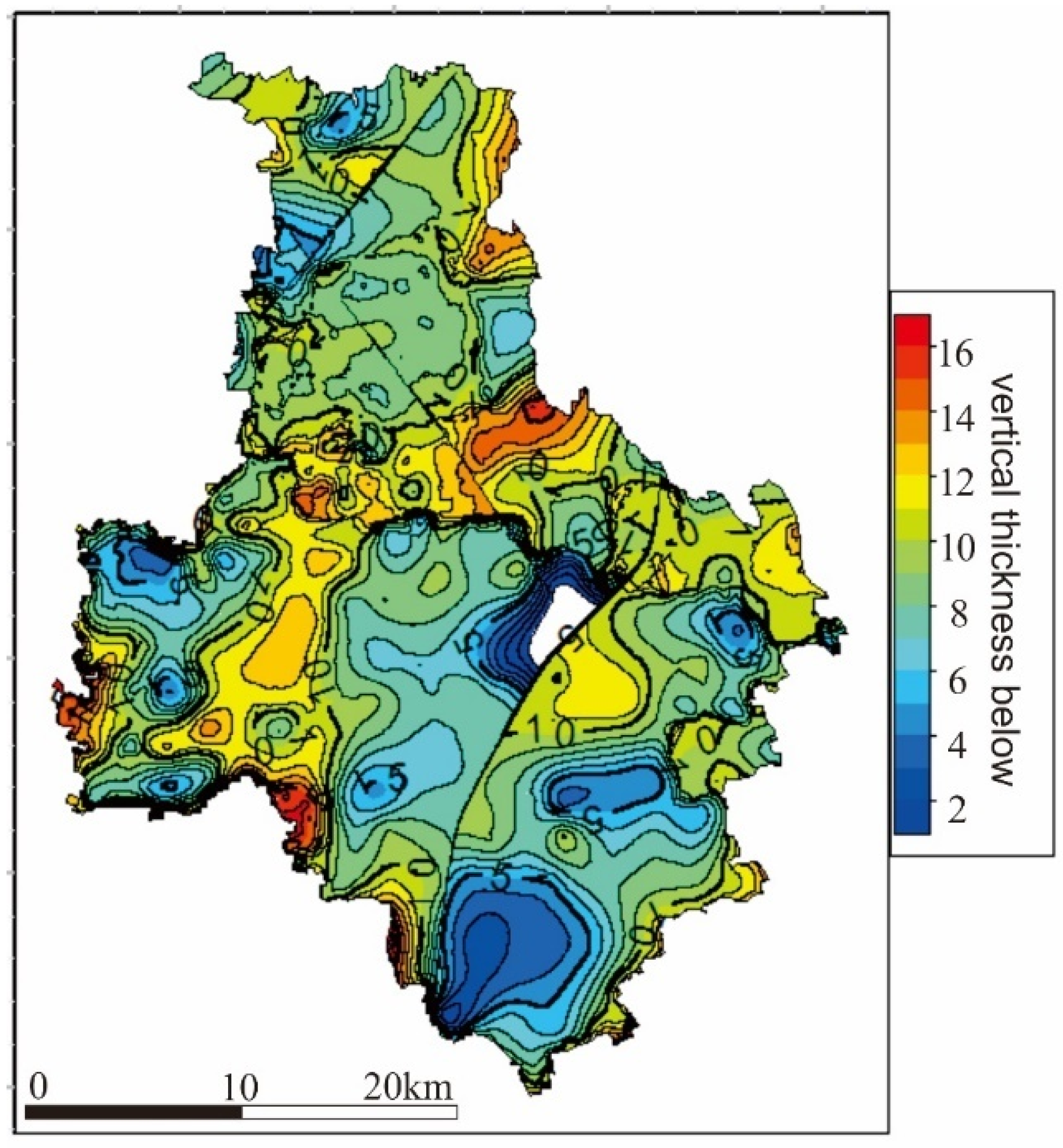

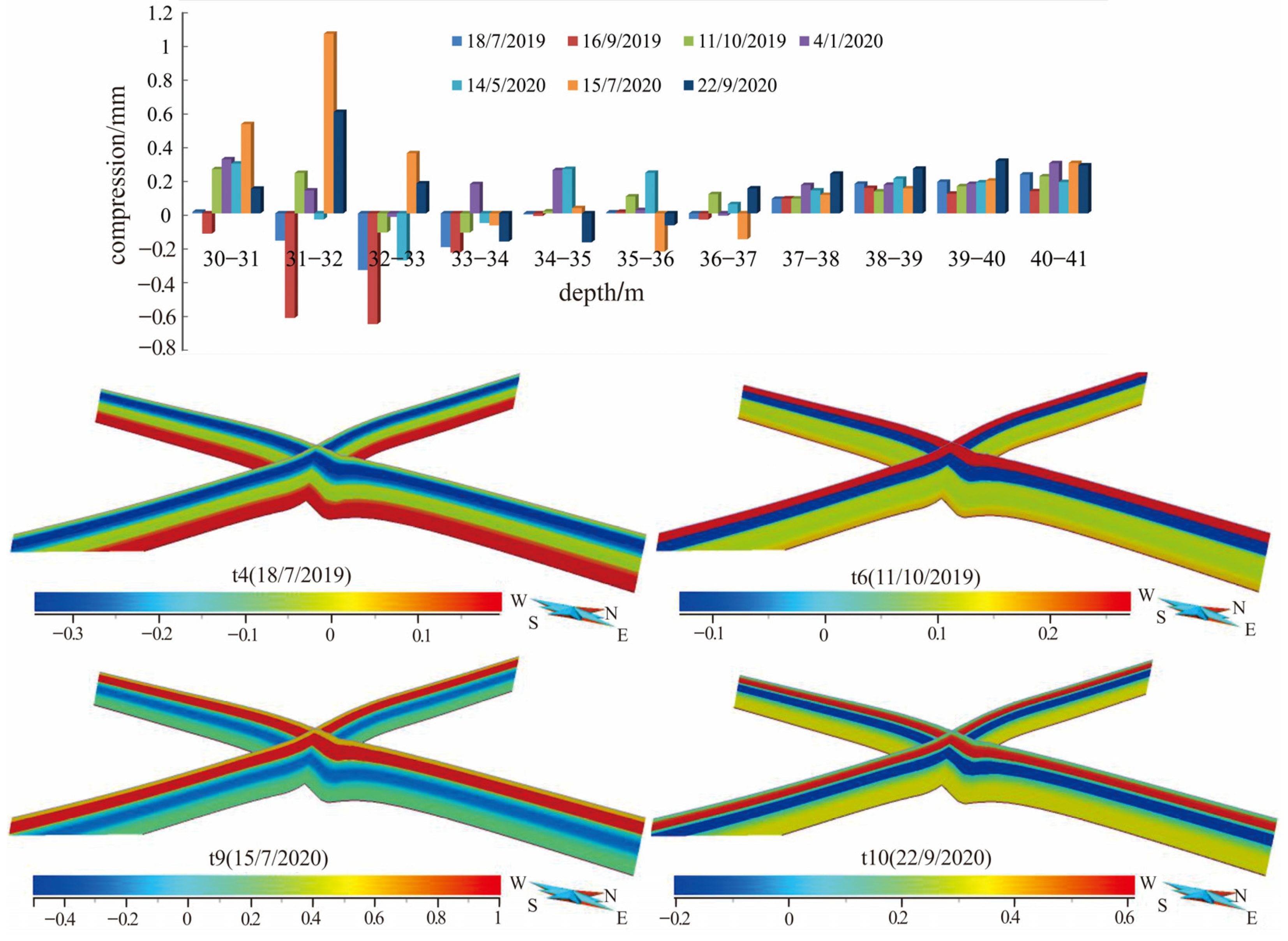
| Geological Units | Unit Thickness (m) | ||||||||||
|---|---|---|---|---|---|---|---|---|---|---|---|
| Derived from the 3D Model | Borehole Data | ||||||||||
| Max | Min | Mean | Std. Dev | Median | Variance | Max | Min | Mean | Std. Dev | ||
| Artificial ground | 3.00 | 0 | 1.31 | 0.20 | 1.35 | 0.04 | 4.10 | 0.28 | 1.12 | 0.56 | |
| The first cyclothem | clayey silt 22 | 7.24 | 0 | 2.95 | 0.47 | 3.04 | 0.22 | 10.1 | 0.4 | 2.72 | 1.47 |
| silty clay 23 | 15.77 | 0 | 3.65 | 0.67 | 3.75 | 0.45 | 10.5 | 0.3 | 3.31 | 1.81 | |
| sand 24 | 40.99 | 0 | 9.08 | 2.77 | 9.08 | 7.66 | 21.1 | 0.1 | 6.68 | 3.96 | |
| gravel 25 | 10.68 | 0 | 2.63 | 1.58 | 2.44 | 2.49 | 11.1 | 1.0 | 4.43 | 2.42 | |
| The second cyclothem | clayey silt 32 | 33.38 | 0 | 4.25 | 2.30 | 3.99 | 5.30 | 12.8 | 0.5 | 3.92 | 2.30 |
| silty clay 33 | 37.45 | 0 | 4.49 | 0.97 | 4.43 | 0.94 | 12.8 | 0.5 | 4.66 | 2.60 | |
| sand 34 | 31.04 | 0 | 11.79 | 1.92 | 11.97 | 3.67 | 23.0 | 1.5 | 11.88 | 3.66 | |
| The third cyclothem | silty clay 43 | 23.67 | 0 | 4.67 | 0.78 | 4.82 | 0.61 | 13.9 | 0.4 | 5.08 | 1.82 |
| sand 44 | 38.42 | 0 | 9.61 | 1.73 | 9.68 | 3.00 | 21.7 | 0.7 | 8.90 | 2.66 | |
| Stratigraphic Structures | Sample Images | Characteristics |
|---|---|---|
| single-layered |  | Homogeneous lithology |
| double-layered |  | Two major layers; lenses may develop locally within major units; heterogeneous lithology and property across two units |
| multilayered |  | Multilayers, containing interbedded layers or lenses, heterogeneous in both lithologies and properties |
| Indicator | Evaluation Criteria | ||
|---|---|---|---|
| 6–10 | 3–6 | 0–3 | |
| Geological conditions | simple | medium | complex |
| Es values (MPa) | ≥15 | 4–15 | ≤4 |
| Stratigraphic structure | single-layered | double-layered | multilayered |
Disclaimer/Publisher’s Note: The statements, opinions and data contained in all publications are solely those of the individual author(s) and contributor(s) and not of MDPI and/or the editor(s). MDPI and/or the editor(s) disclaim responsibility for any injury to people or property resulting from any ideas, methods, instructions or products referred to in the content. |
© 2023 by the authors. Licensee MDPI, Basel, Switzerland. This article is an open access article distributed under the terms and conditions of the Creative Commons Attribution (CC BY) license (https://creativecommons.org/licenses/by/4.0/).
Share and Cite
He, H.; Xiao, J.; He, J.; Wei, B.; Ma, X.; Huang, F.; Cai, X.; Zhou, Y.; Bi, J.; Zhao, Y.; et al. Three-Dimensional Geological Modeling of the Shallow Subsurface and Its Application: A Case Study in Tongzhou District, Beijing, China. Appl. Sci. 2023, 13, 1932. https://doi.org/10.3390/app13031932
He H, Xiao J, He J, Wei B, Ma X, Huang F, Cai X, Zhou Y, Bi J, Zhao Y, et al. Three-Dimensional Geological Modeling of the Shallow Subsurface and Its Application: A Case Study in Tongzhou District, Beijing, China. Applied Sciences. 2023; 13(3):1932. https://doi.org/10.3390/app13031932
Chicago/Turabian StyleHe, Hanhan, Jingze Xiao, Jing He, Bo Wei, Xiaogang Ma, Fan Huang, Xiangmin Cai, Yuanxin Zhou, Jingyi Bi, Yiting Zhao, and et al. 2023. "Three-Dimensional Geological Modeling of the Shallow Subsurface and Its Application: A Case Study in Tongzhou District, Beijing, China" Applied Sciences 13, no. 3: 1932. https://doi.org/10.3390/app13031932
APA StyleHe, H., Xiao, J., He, J., Wei, B., Ma, X., Huang, F., Cai, X., Zhou, Y., Bi, J., Zhao, Y., Wang, C., & Wei, J. (2023). Three-Dimensional Geological Modeling of the Shallow Subsurface and Its Application: A Case Study in Tongzhou District, Beijing, China. Applied Sciences, 13(3), 1932. https://doi.org/10.3390/app13031932







